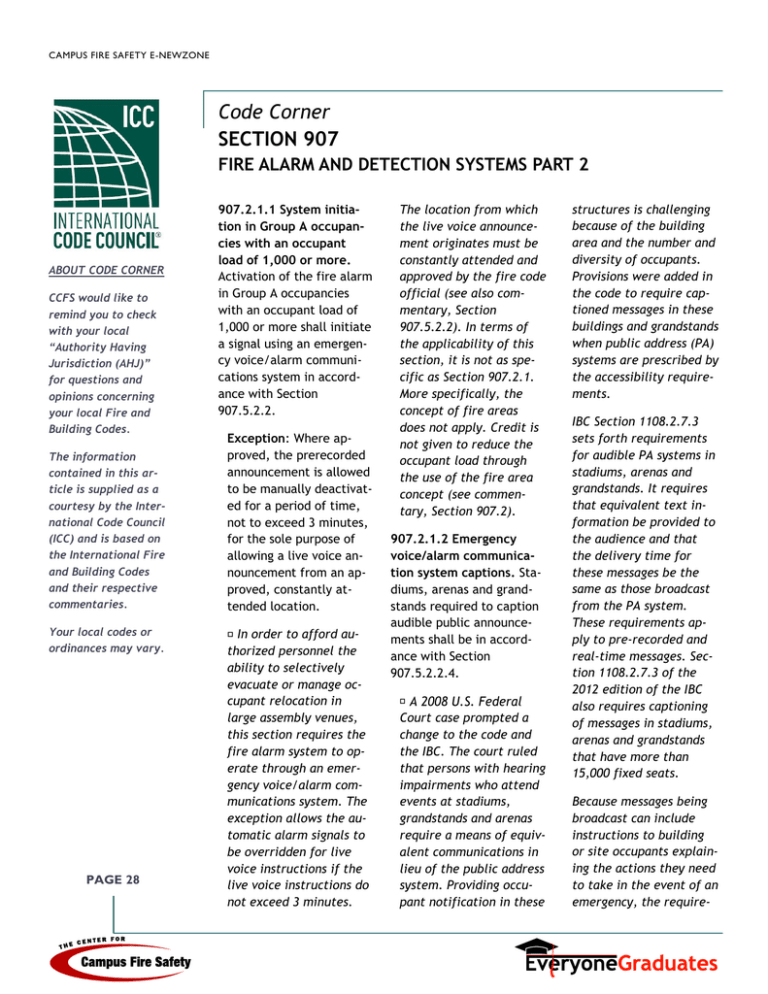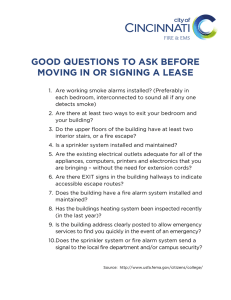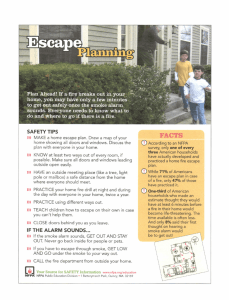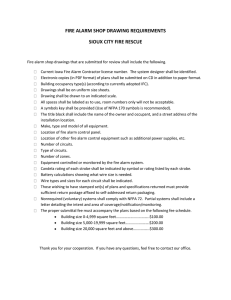
CAMPUS FIRE SAFETY E-NEWZONE
Code Corner
SECTION 907
FIRE ALARM AND DETECTION SYSTEMS PART 2
ABOUT CODE CORNER
CCFS would like to
remind you to check
with your local
“Authority Having
Jurisdiction (AHJ)”
for questions and
opinions concerning
your local Fire and
Building Codes.
The information
contained in this article is supplied as a
courtesy by the International Code Council
(ICC) and is based on
the International Fire
and Building Codes
and their respective
commentaries.
Your local codes or
ordinances may vary.
PAGE 28
907.2.1.1 System initiation in Group A occupancies with an occupant
load of 1,000 or more.
Activation of the fire alarm
in Group A occupancies
with an occupant load of
1,000 or more shall initiate
a signal using an emergency voice/alarm communications system in accordance with Section
907.5.2.2.
Exception: Where approved, the prerecorded
announcement is allowed
to be manually deactivated for a period of time,
not to exceed 3 minutes,
for the sole purpose of
allowing a live voice announcement from an approved, constantly attended location.
In order to afford authorized personnel the
ability to selectively
evacuate or manage occupant relocation in
large assembly venues,
this section requires the
fire alarm system to operate through an emergency voice/alarm communications system. The
exception allows the automatic alarm signals to
be overridden for live
voice instructions if the
live voice instructions do
not exceed 3 minutes.
The location from which
the live voice announcement originates must be
constantly attended and
approved by the fire code
official (see also commentary, Section
907.5.2.2). In terms of
the applicability of this
section, it is not as specific as Section 907.2.1.
More specifically, the
concept of fire areas
does not apply. Credit is
not given to reduce the
occupant load through
the use of the fire area
concept (see commentary, Section 907.2).
907.2.1.2 Emergency
voice/alarm communication system captions. Stadiums, arenas and grandstands required to caption
audible public announcements shall be in accordance with Section
907.5.2.2.4.
Court case prompted a
change to the code and
the IBC. The court ruled
that persons with hearing
impairments who attend
events at stadiums,
grandstands and arenas
require a means of equivalent communications in
lieu of the public address
system. Providing occupant notification in these
structures is challenging
because of the building
area and the number and
diversity of occupants.
Provisions were added in
the code to require captioned messages in these
buildings and grandstands
when public address (PA)
systems are prescribed by
the accessibility requirements.
IBC Section 1108.2.7.3
sets forth requirements
for audible PA systems in
stadiums, arenas and
grandstands. It requires
that equivalent text information be provided to
the audience and that
the delivery time for
these messages be the
same as those broadcast
from the PA system.
These requirements apply to pre-recorded and
real-time messages. Section 1108.2.7.3 of the
2012 edition of the IBC
also requires captioning
of messages in stadiums,
arenas and grandstands
that have more than
15,000 fixed seats.
Because messages being
broadcast can include
instructions to building
or site occupants explaining the actions they need
to take in the event of an
emergency, the require-
CAMPUS FIRE SAFETY E-NEWZONE
Code Corner
About the 2012 Edition
… The Center will be
publishing sections of the
2012 IFC for your review
and comparison. Please
note that CCFS is not
suggesting you adopt this
new regulation. Any
regulations used in your
state/organization should
be in accordance with the
recommendations set
forth by your
local Building
Regulations
Organization and State
Fire Marshal’s Office.
The excerpts from The
2009 and 2012 International Fire Code are reprinted with the permission of the International
Code Council.
All rights reserved.
PAGE 29
ments of NFPA 72 are
applicable for captioning
systems. Such a system
falls within the scope of
Chapter 24 of NFPA 72,
of “Emergency Communication Systems.” NFPA
72 defines an emergency
communications system
(ECS) as a system designed for life safety
that indicates the existence of an emergency
and communicates the
appropriate response
and action. The ECS is
required to be classified
as either a one- or twoway path system. It can
be within a building or
over a wide area or can
be targeted to a particular group of recipients.
The messages that will
be broadcast are based
on an emergency response plan developed
during a risk analysis by
the project stakeholders
and is approved by the
fire code official.
The NFPA 72 ECS requirements are based on
in-building or wide-area
occupant notification.
Wide-area systems could
include the entire area
of a jurisdiction. For a
stadium, arena or grandstand captioning, NFPA
72 defines these as mass
notification systems
(MNS). In the context of
the NFPA 72 requirements, this particular
code change requires a
one-way MNS where instructions are broadcast
by personnel authorized
to distribute messages.
This could include firefighters during a fire
event; the system could
be used by law enforcement officers during a
domestic terrorism incident or a weather event
like a tornado warning.
The design of the compliant MNS in Chapter 24
of NFPA 72 is not prescriptive—a MNS is a performance- based design.
Accordingly, fire code
officials should require
their design to be sealed
by a registered professional engineer. Section
24.7 of the standard requires the preparation
of a risk analysis based
on the nature and anticipated risks of the facility. The risk analysis is
part of the design brief,
which will serve as the
basis of the system design and is a required
design document. NFPA
72 requires the following
elements included in the
risk analysis:
• The number of persons
within the building, area, space, campus or
region;
• The character of the
occupancy, such as
unique hazards and the
rate at which the hazard
can develop;
• The anticipated threats,
including natural, technological and intentional
events;
• The reliability and performance of the MNS;
• Security of the MNS and
its components;
• How the building or
staff implement the risk
analysis, including the use
of the MNS; and
• How emergency services, such as the fire service and law enforcement
agencies, can employ the
MNS.
In a stadium or arena, the
captioning system is required to be a component
of the emergency voice/
communication alarm system (EV/ACS). Such a system is required by Section
907.2.1.1 in Group A occupancies with an occupant
load of 1,000 or more.
The requirement in Section 907.5.2.2.4 specifies
the captioning system
would be connected to
the EV/ ACS. The fire
alarm control unit will
require a listed interface
unit capable of displaying
text messages. Textual
visible appliances are allowed by NFPA 72 when
used in conjunction with
CAMPUS FIRE SAFETY E-NEWZONE
Code Corner
audible, visual or both
types of notification appliances. In the public
mode, textual visible
appliances are located to
ensure readability by the
building occupants. Such
a system can display messages using televisions or
light-emitting diode
(LED) marquee signs.
PAGE 30
The design concept of
MNS is relatively new in
the design community.
Captioning systems might
utilize components that
are not listed for fire
alarm service so the design will be required to
comply with Section
24.2.2.21 of NFPA 72 for
textual visible notification appliances. Emergency textual messages
take precedence over any
nonemergency text messages. Under NFPA 72,
these devices require a
primary and secondary
power supply. If the devices are not monitored
for integrity or loss of
communications by an
autonomous control or a
fire alarm control unit,
the appliance must clearly display its status. The
size of characters displayed must comply with
the requirements in NFPA
72. The NFPA 72 size,
character and font requirements are based on
the location of the display in relation to the
height and distance from
the persons viewing it.
907.2.2 Group B. A manual fire alarm system shall
be installed in Group B occupancies where one of the
following conditions exists:
1. The combined Group B
occupant load of all floors
is 500 or more.
2. The Group B occupant
load is more than 100 persons above or below the
lowest level of exit discharge.
3. The fire area contains
an ambulatory care facility.
Exception: Manual fire
alarm boxes are not required where the building
is equipped throughout
with an automatic sprinkler system installed in
accordance with Section
903.3.1.1 and the occupant notification appliances will activate
throughout the notification zones upon sprinkler
water flow.
Group B occupancies
generally involve individuals or groups of people
in separate office areas.
As a result, the occupants are not necessarily
aware of what is going on
in other parts of the
building. Group B buildings with large occupant
loads, even in single-
story buildings, or where
a substantial number of
occupants are above or
below the level of exit
discharge, increase the
difficulty of alerting the
occupants of a fire. This
is especially true in nonsprinklered buildings
with given occupant load
thresholds. Group B occupancies include a specific
use called ambulatory
care facilities which present a higher level of life
hazard than the typical
Group B occupancy. The
fact that the care recipients of such facilities
may be rendered incapable of self-preservation
for limited periods of
time makes the need for
a fire alarm system critical. Section 907.2.2 requires a manual alarm
system any time a fire
area contains a ambulatory care facility. See the
commentary to Section
202, definition of
“Ambulatory care facility” and Section
907.2.2.1.
The exception does not
eliminate the fire alarm
system, but rather permits it to be initiated
automatically by the
sprinkler waterflow
switch(es) instead of by
the manual fire alarm
boxes.
907.2.2.1 Ambulatory
care facilities. Fire areas
CAMPUS FIRE SAFETY E-NEWZONE
Code Corner
containing ambulatory
care facilities shall be provided with an electronically supervised automatic
smoke detection system
installed within the ambulatory care facility and in
public use areas outside of
tenant spaces, including
public corridors and elevator lobbies.
Exception: Buildings
equipped throughout
with an automatic sprinkler system in accordance with Section
903.3.1.1 provided the
occupant notification
appliances will activate
throughout the notification zones upon sprinkler
water flow.
PAGE 31
Years ago, few surgical
procedures were performed outside of a hospital. Today, complex
outpatient surgeries conducted outside of a hospital are commonplace.
They are performed in
facilities often called
“day surgery centers” or
“ambulatory surgical
centers” because patients are able to walk in
and walk out the same
day. Procedures render
care recipients temporarily incapable of selfpreservation by application of nerve blocks, sedation or anesthesia;
however, they do typically recover quickly.
The IBC identifies health
care Group I occupancies
as including a 24-hour
stay. Without a 24-hour
stay, these surgery centers were classified as
Group B, which allowed
the care providers to
render an unlimited
number of people incapable of selfpreservation with no
more protection than a
business office. Since
these types of facilities
contain distinctly different hazards to life safety than other Group B
occupancies, they are
now required to have a
higher level of life safety and fire protection as
evidenced by the requirements of this section, as well as Section
903.2.2 and the construction provisions of
the code.
This section more specifically states that any
time a fire area contains
an ambulatory care facility, the fire area
should be provided with
a supervised smoke detection system in the
ambulatory care facility
and in public use areas
outside of tenant spaces.
Therefore, in a medical
office building, for example, the ambulatory
care facility contained
within would have a full
coverage system. The
other offices in the
building would not require smoke detection in
the individual tenant
spaces but instead in the
public areas, such as lobby or lounge areas.
The exception does not
eliminate the fire alarm
system, but rather permits it to be initiated
automatically by the
sprinkler water flow
switch(es) instead of by
manual fire alarm boxes.
907.2.3 Group E. A manual fire alarm system that
initiates the occupant notification signal utilizing
an emergency voice/
alarm communication system meeting the requirements of Section 907.5.2.2
and installed in accordance with Section 907.6
shall be installed in Group
E occupancies. When automatic sprinkler systems or
smoke detectors are installed, such systems or
detectors shall be connected to the building fire
alarm system.
Exceptions:
1. A manual fire alarm
system is not required in
Group E occupancies
with an occupant load of
30 or less.
2. Manual fire alarm boxes are not required in
Group E occupancies
where all of the following apply:
CAMPUS FIRE SAFETY E-NEWZONE
Code Corner
2.1. Interior corridors
are protected by smoke
detectors.
2.2. Auditoriums, cafeterias, gymnasiums and
similar areas are protected by heat detectors or other approved
detection devices.
2.3. Shops and laboratories involving dusts or
vapors are protected by
heat detectors or other
approved detection devices.
3. Manual fire alarm boxes shall not be required
in Group E occupancies
where the building is
equipped throughout with
an approved automatic
sprinkler system installed
in accordance with Section 903.3.1.1, the emergency voice/alarm communication system will
activate on sprinkler water flow and manual activation is provided from a
normally occupied location.
PAGE 32
Section 404.3.3 addresses the development
and implementation of
lockdown plans. These
requirements were developed to ensure that the
level of life safety inside
of the building is not reduced or compromised
during a lockdown. In
order for a building to
safely function in a lock-
down condition, the code
requires a means of communication between the
established central location and each secured
area. Section 404.3.3.1
does not prescribe the
means of communication,
which could include the
use of text messages to
cell phones/mobile devices, e-mail messages or
the use of preestablished audio or visual signals. The provisions
in Section 404.3.3 are not
specific to Group E occupancies—they are applicable to all occupancies
that develop and implement lockdown plans.
Because of concerns of
school campus safety
serving kindergarten
through 12th grade students, specific requirements were put into the
2012 edition of the IBC
and the code for enhanced communication
between the school administrators, teachers
and students when a
lockdown plan is activated in Group E occupancies. As a result, emergency voice/alarm communication systems (EV/
ACS) are prescribed in
Group E occupancies.
Previously the code
would have permitted
the manual fire alarm
system to use audible
and visible alarm notifi-
cation appliances and did
not require the added
capabilities that an EV/
ACS provides.
Section 907.2.3 sets
forth the requirements
for automatic fire alarm
and detection system
requirements in Group E
occupancies. Section
907.2.3 prescribes the
installation of an EV/ACS
as opposed to a traditional horn/strobe occupant
notification system.
Exception 1 exempts
Group E occupancies from
requiring a fire alarm
system when the occupant load is less than 30.
This would exempt small
day care centers that
serve children older than
21 /2 years of age or a
small Sunday school
classroom at a place of
religious worship.
Exception 2 exempts
manual fire alarm boxes
in interior corridors, laboratories, auditoriums,
cafeterias, gymnasiums
and similar spaces based
on the installation of
heat/smoke detectors.
This is not an exception
from the EV/ACS but
simply an exemption of
locations requiring manual fire alarm boxes. The
applicability of Exception
2 is independent of
whether an automatic
sprinkler system is in-
CAMPUS FIRE SAFETY E-NEWZONE
Code Corner
stalled. If an automatic
smoke detection system
is installed, it must be
connected to the building fire alarm system.
Exception 3 allows the
omission of the manual
fire alarm boxes in
Group E occupancies
equipped throughout
with an automatic sprinkler system if the actuation of the sprinkler system will activate the
EV/ ACS. See Section
903.2.3 for sprinkler requirements in Group E
buildings.
907.2.4 Group F. A manual fire alarm system that
activates the occupant
notification system in accordance with Section
907.5 shall be installed in
Group F occupancies
where both of the following conditions exist:
1. The Group F occupancy is two or more stories
in height; and
2. The Group F occupancy has a combined occupant load of 500 or more
above or below the lowest level of exit discharge.
PAGE 33
Exception: Manual fire
alarm boxes are not required where the building is equipped throughout with an automatic
sprinkler system installed
in accordance with Sec-
tion 903.3.1.1 and the
occupant notification
appliances will activate
throughout the notification zones upon sprinkler
water flow.
This section is intended to apply to large multistory manufacturing
facilities. For this reason, a manual fire alarm
system would be required only if the building were at least two
stories in height and had
500 or more occupants
above or below the level
of exit discharge. An
unlimited area, twostory Group F occupancy
complying with Section
507.3 of the IBC would
be indicative of an occupancy requiring a manual
fire alarm system.
Buildings in compliance
with Section 507.3 of the
IBC, and large manufacturing facilities in general, however, must be
fully sprinklered and
would thus be eligible
for the exception. The
exception does not eliminate the fire alarm system but rather permits
it to be initiated automatically by the sprinkler system waterflow
switch(es) instead of by
the manual fire alarm
boxes.
907.2.5 Group H. A manual fire alarm system that
activates the occupant
notification system in accordance with Section
907.5 shall be installed in
Group H-5 occupancies
and in occupancies used
for the manufacture of
organic coatings. An automatic smoke detection
system shall be installed
for highly toxic gases, organic peroxides and oxidizers in accordance with
Chapters 60, 62 and 63,
respectively.
Because of the nature
and potential quantity of
hazardous materials in
Group H-5 occupancies, a
manual means of activating an occupant notification system is essential for the safety of the
occupants. In accordance
with Section 2703.11,
the activation of the
alarm system must initiate a local alarm and
transmit a signal to the
emergency control station. The manual fire
alarm system requirement for the building is
in addition to the emergency alarm requirements in Section 2703.12
(see Section 908.2).
Occupancies involved in
the manufacture of organic coatings present
special hazardous conditions because of the unstable character of the
materials, such as nitrocellulose. Good house-
CAMPUS FIRE SAFETY E-NEWZONE
Code Corner
keeping and control of
ignition sources is critical. Chapter 29 contains
additional requirements
for organic coating manufacturing processes.
This section also requires
an automatic smoke detection system in certain
occupancy conditions involving either highly toxic gases or organic peroxides and oxidizers. The
need for the automatic
smoke detection system
may depend on the class
of materials and additional levels of fire protection provided. This
requirement also assumes
the quantity of materials
is in excess of the maximum allowable quantities shown in Tables
5003.1.1(1) and 5003.1.1
(2).
Next Month ...
907.2.6.1 Group I-1.
An automatic smoke
detection system shall
be
PAGE 34
907.2.6 Group I. A manual
fire alarm system that activates the occupant notification system in accordance with Section 907.5
shall be installed in Group I
occupancies. An automatic
smoke detection system
that activates the occupant
notification system in accordance with Section
907.5 shall be provided in
accordance with Sections
907.2.6.1, 907.2.6.2 and
907.2.6.3.3.
Exceptions:
1. Manual fire alarm
boxes in sleeping units
of Group I-1 and I-2 occupancies shall not be
required at exits if located at all care providers’ control stations or
other constantly attended staff locations, provided such stations are
visible and continuously
accessible and that
travel distances required in Section
907.4.2.1 are not exceeded.
section to require a
smoke detection system
throughout all Group I
occupancies. Smoke detectors are only generally
required in the corridors
and in waiting rooms that
are open to corridors,
unless noted otherwise.
IFC Committee Interpretation No. 36-03 makes it
clear that the Group I
provisions only require a
manual fire alarm system
with smoke detectors in
selected areas.
2. Occupant notification
systems are not required to be activated
where private mode
signaling installed in
accordance with NFPA
72 is approved by the
fire code official.
To reduce the potential
for unwanted alarms,
manual fire alarm boxes
may be located at the
care providers’ control
stations or another constantly attended location.
Because the protection
and possible evacuation
of the occupants in Group
I occupancies are most
often dependent on the
response by care providers, occupancies in Group
I must be protected with
a manual fire alarm system and in certain instances, as described in
Sections 907.2.6.1,
907.2.6.2 and 907.2.6.3,
an automatic smoke detection system. In Group
I-1, smoke alarms are
also required in accordance with Section
907.6.1.1.
It is not the intent of this
Exception 1 reduces the
likelihood of accidental
or malicious false alarm
system activations by
manual means by allowing the pull stations to
be located in a more controlled area. It assumes
the approved location is
always accessible by care
providers and within 200
feet (60 960 mm) of travel distance. Exception 2
allows the common practice in Group I occupancies of only notifying the
care providers instead of
all building occupants in
the event of a fire, subject to the approval of
the fire code official.




